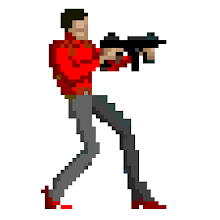I had the opportunity to play Terry Cavanagh's excellent VVVVVV just after its release. It was purchased for me as a birthday gift, and it was a fantastic selection. There are a lot of reasons to like this game -- excellent soundtrack, fantastically captured retro nouveau feel, hilariously named rooms, and lots of clever references to games and culture from days of yore.
The real winner in this, however, is the very same thinking that pervades most highly-successful indie games (and in some cases, highly-successful mainstream commercial games as well). The game is succinct and simple; I've heard it compared to the Metroidvania genre, a comparison I'm not entirely sure is valid. VVVVVV does lift ideas from Metroid-style games, such as the map, free exploration with your current powers, and so forth. The difference is in the linearity, or rather the lack thereof. A hallmark of most Metroidvania style games is that areas of the map are closed off to you until you acquire a certain item or power to overcome the obstacle closing it off; in VVVVVV, the only pickups to find are the "Shiny Trinkets", a set of 20 items enabling unlocks.
No, the entirety of the gameplay in VVVVVV comes from the thorough explanation and exhaustion of a mechanic derived from three commands: move left, move right, and flip. Captain Viridian doesn't jump, he flips the direction of gravity locally for himself, moving from floor to ceiling and back again. The game is still at its heart a platformer, but not the standard run and jump fare.
Flipping gravity requires you to think a bit outside the box, both for what you can do with it, and what you can't. A few puzzles rely on the fact that your character cannot move "up" under his own power without flipping. One great example involves a trio of vertically-moving platforms, and a ceiling coated in spikes. The player can't flip, because he would die on the ceiling, so he's forced to wait until the platforms align and walk off one onto the next. Another is a puzzle which puts a Shiny Trinket in front of the player, blocked by a small box. Of course, Viridian can't just jump over the box, he has to flip -- and the only safe platform on the ceiling is *six rooms up*.
In trademark style, each area puts a different spin on the mechanic, requiring different thinking to accomplish. There is a basic area similar to the first mission, which relies on simple (if you can call it that) flipping. Another scrolls vertically, requiring that the player not be too quick or slow or he'll get killed on the edges of the screen. Still another adds beams which will flip you on contact; tactically moving through them to move through maze-type rooms is a fun challenge. Finally, there is an area in which the sides of the screen don't necessarily link to new rooms; they can wrap around to the other side of the room horizontally or vertically. The "final challenge" adds all of these together to produce a mind-bending sequence of puzzles in the home stretch.
The structure of VVVVVV is oddly familiar; the acclaimed Braid did the same thing with its time mechanic, subtly changing the rules of the world with each broad area to add complications to the player's actions. This is not to say VVVVVV "ripped off" or even referenced that game's structure; in some cases, great minds do think alike, and we find that thorough exploration of a single mechanic, a recurring hallmark of indie games in general, produces titles that rival sixty-dollar titles for fun factor.
Stretching this out a bit, we could argue that the exploration of a mechanic practically defines the genre. It largely depends on your definition of "mechanic", but games like shoot-'em-ups could be considered one-mechanic games; that mechanic is flying vertically/horizontally, attacking enemies firing upward/to the right. Bullet-hell games take this to its extreme, making dodging the primary mechanic even more so than shooting enemies. Interlacing multiple mechanics is doable, but developers always run the risk of stretching too thin, or trying to combine genres that have no business together. (For example, why is there a vehicle dodging game in Resident EVil 4? I'm battling mechanics I'm unfamiliar with, I just beat the final boss, and now you expect me to perform this minigame perfectly or die each time I hit the smallest thing? I swear I died on that sequence more than the rest of the game combined.)
The one-mechanic ideal that makes indie games so succinct and pleasurable in their simultaneous simplicity and complexity calls out to classic games, both video (consider Breakout, Centipede, hell, even modern rail shooters) and otherwise (chess? backgammon? poker?). The success or failure of it depends on the execution, but it's never a bad place to start. And with VVVVVV, Terry Cavanagh has proven he is a master of the concept.
Friday, February 5, 2010
Subscribe to:
Comments (Atom)



